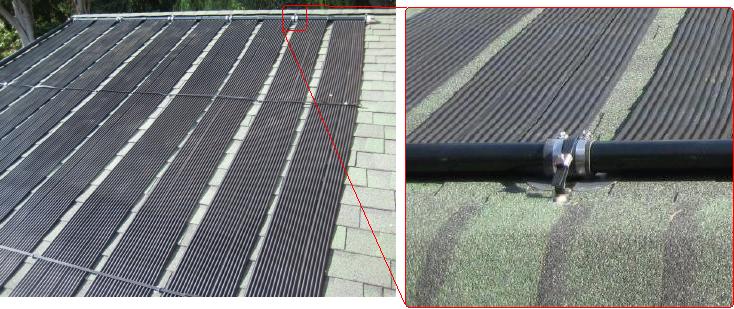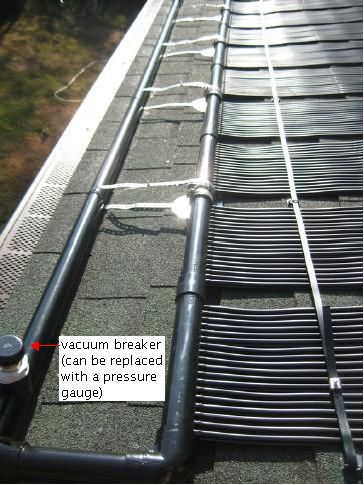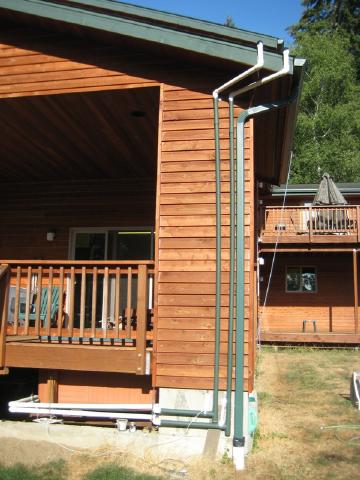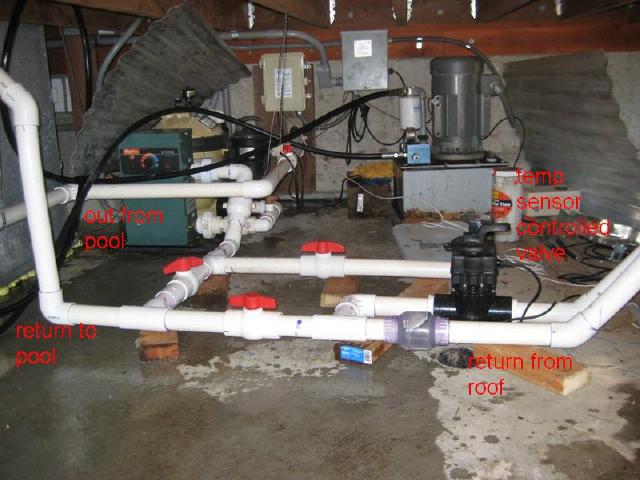DIY Solar Pool Heating in Seattle
The following is a DIY installation of a commercial solar pool heating system
done by Doug ( ) located
in Seattle, Washington, USA. Thank you to Doug for the photos and details.
The text is taken from a collection of emails from him. Any
errors in translating them to this format are mine.
) located
in Seattle, Washington, USA. Thank you to Doug for the photos and details.
The text is taken from a collection of emails from him. Any
errors in translating them to this format are mine.
The roof is a 3/12 pitch (the roof goes up 3" for every 12" horizontal.) Even though it was a commercial system, it was a fair bit of work doing the installation.
I'm heating a small pool of about 2,700 gallons. The surface area is 120 square feet and the pool gets almost no direct sun as it is covered by a porch roof. I purchased the Powerstrip product from Hot Sun Industries Inc. (http://www.h2otsun.com) to cover about 160 square feet of roof. I also, got a valve actuator and a Suntouch controller box. I have a sensor in the solar panels and a sensor in the water. When the solar panels are at least 6 degrees warmer than the pool and the pool is below the maximum temperature the electric valve actuator opens to let water go to the solar and the circulation pump kicks on.




In the photo above, the valve next to the text "out from pool" is for mixing. Hot Sun recommends starting your solar system with that valve completely open. Most likely no water will go up to the roof with it all the way open. Then you slowly close it off until water flows back from the roof on the return. They give you a clear 1 way valve to monitor this (see bottom pipe in photo above.) This way you minimize the pressure on the solar strips. In the kit they include a vacuum breaker and a pressure gauge. When you first start they recommend removing the vacuum breaker and putting in the pressure gauge. They suggest to shoot for 2-3 PSI or less.
My pump is a Pinnacle 3/4 HP that's about 10 years old. It needs to push water through the filter but I suspect I could go to a 1/2 horse power or less. I'll be looking into that in the future as this pump is really leaking. I've used marine epoxy on some places and it has worked but it seems to have more leaks. Also, I figure since it is 10 years old newer pumps would be much more efficient.
Performance
I have some performance information. It's funny because Seattle hit a record 103 degrees farenheit about a week before I had the system installed. After I got the solar installed I had three days of dark clouds where the system only turned on a couple of times for 30 minutes or so. On the 4th day we had good sun in the afternoon. For the period between about noon and 5pm it increased the temperature of the pool by about 1.5 degrees per hour. That day the pool went up by about 8 degrees total. Today (August 16, 2009) we had another good day and the performance was similar, 1.5 degrees increase per hour from noon to 5pm. When I use an electric heater I get a little less than half that increase per hour and the heater uses 23 amps of 220.
After some dark cloudy days my pool was at 71 degrees on Sunday morning. Over the next three days the pool had the following readings:
| Morning | Early Evening | ||
| Sunday | 71 | 80 | |
| Monday | 77 | 84 | |
| Tuesday | 81 | 90 |
I was pretty stunned that it heated up this quickly. I also found out 90 is just too hot to do much swimming in. I will now set my maximum pool temperature down to 86. With better cover insulation on the pool I'm hoping I can reduce the night temperature loss and allow me to keep the pool operational into October.
|
Do you have a project you'd like to share on rimstar.org too? You're more than welcome to. Click here for details. |
|

